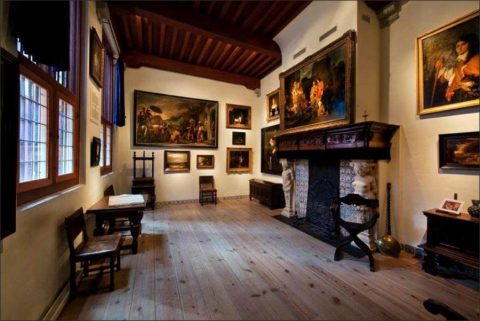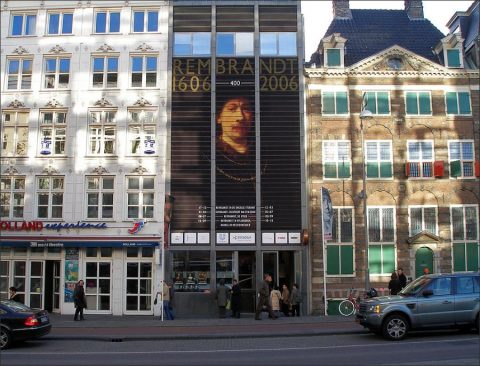The Rembrandthuis Museum is located in the center of Amsterdam, near the famous Waterlooplein and on a 15 minutes’ walk from Amsterdam’s Central Station.
In Rembrandt’s lifetime, Amsterdam was in the middle of a period of unprecedented wealth when culture flourished. When Rembrandt’s success as an artist enabled him to buy the impressive merchant’s house in Sint Antoniesbreestraat, present-day Jodenbreestraat, only part of the canal ring had been built and Sint Antoniesbreestraat attracted the elite.
This neighbourhood was home to the A-list of the Amsterdam art world, including Rembrandt’s teacher, Pieter Lastman, and the artists Nicolaes Eliasz Pickenoy and Pieter Codde. The ruling class, such as the later burgomasters Johan Huydecoper van Maarsseveen and Gillis Valckenier, were also well represented there. The wealthy Nicolaes van Bambeeck had a house immediately opposite; Rembrandt painted portraits of this merchant and his wife Agatha in the year he painted The Night Watch. They remain two of the finest paintings in Dutch portrait history.
Eight years after his tempestuous entry into the Amsterdam art market Rembrandt bought the substantial building, now the Rembrandt House, which had been built in the year he was born. A few years before he moved there the house had been remodelled, probably by Jacob van Campen, the architect who designed what is now the Royal Palace in Dam Square. Rembrandt lived and worked behind the oak door and the red shutters for almost twenty years. This is the place where in his thirties he celebrated his glory years, primarily as a portrait painter, and where he went on to make his subdued, more heavily impasted work until bankruptcy forced him to give the house up.
A Turbulent Time
Rembrandt was at the height of his fame when he moved into this house with his beloved Saskia Uylenburgh, a burgomaster’s daughter from Leeuwarden. He mixed in the highest circles and was awarded the most prestigious commissions by merchants, patricians and clergymen. It was a turbulent time in the house, where bad times followed good in quick succession. The Night Watch was painted in the house, his wife gave birth to three children there, all of whom died within a few months, before their son Titus, who was to survive to adulthood, was born. Soon afterwards Saskia died in the same bed—probably from tuberculosis—leaving Rembrandt with their infant son.
The Etchings as a Window on Rembrandt’s life
It was here, in Sint Anthoniesbreestraat, that Rembrandt etched the most famous prints known to art history, among them The Hundred Guilder Print (1643-49), The Three Trees (1643) and The Three Crosses (1653). The Rembrandt House Museum has an almost complete collection of his etchings, giving an insight into the artist’s life. Many of them show what went on in the workshop. Above all they accurately display the master’s hand.
Pride Goes Before a Fall
For a long time all went well in Rembrandt’s household. The workshop produced an enormous quantity of paintings, drawings and etchings. The best pupils came to be trained. Rembrandt was a passionate collector and the house was crammed with a breathtaking collection of paintings, prints, rarities and other objets d’art. It was the setting for the artist’s turbulent love-life. And it was where Rembrandt encountered the dark side of his unbridled ambition, which sometimes escalated into hubris. He was faced with the impact of a declining market, with a change in his elite clients’ tastes and with the consequences of his extravagant lifestyle.
In the end it led to his bankruptcy. In 1658, when Rembrandt was fifty-two, he was finally forced to leave his house, and move with his mistress Hendrickje Stoffels, their young daughter Cornelia and Rembrandt’s seventeen-year-old son Titus to a modest rented house on Rozengracht. This building in Amsterdam’s Jordaan district had none of the style of the Rembrandt House and was demolished in the nineteenth century. Now a commemorative plaque is all there is to show where the artist spent the last twelve years of his life.
The Resurrection of the Rembrandt House
At the beginning of the twentieth century the Rembrandt House was in a state of severe dilapidation. Few knew that the famous artist had once lived there. It was only later that people realized how important to Amsterdam this cultural inheritance was. Thorough restoration undertaken between 1908 and 1911 saved the building. From then on the house was used as a museum, where Rembrandt’s prints were exhibited. In 1998 a new, modern museum wing was added to the left of the house. The interior of the former dwelling was restored as far as possible to the style of Rembrandt’s time. The seventeenth-century furniture, objets d’art and utensils project a powerful image of Rembrandt’s possessions up to the moment he went bankrupt.
The Rembrandthuis Museum
The museum is located in the center of Amsterdam, near the famous Waterlooplein and on a 15 minutes’ walk from Amsterdam’s Central Station.
Opening Hours 2018
Daily: 10 AM – 6 PM
In 2018 the museum is closed on the 27th of April and 25th of December. On 24th and 31rd of December we close at 17:00) On the 1st of January 2019 it opens at 11:00.
Entrance Fees 2018
Adults: €13
Children under age 6: Free
Children age 6 to 17: € 4,00
Museumcard: Free
ISIC Card: € 10,00
I Amsterdam City Card: Free
Friends of the Museum: free
All prices include the museum’s audio guide
Hits: 44

